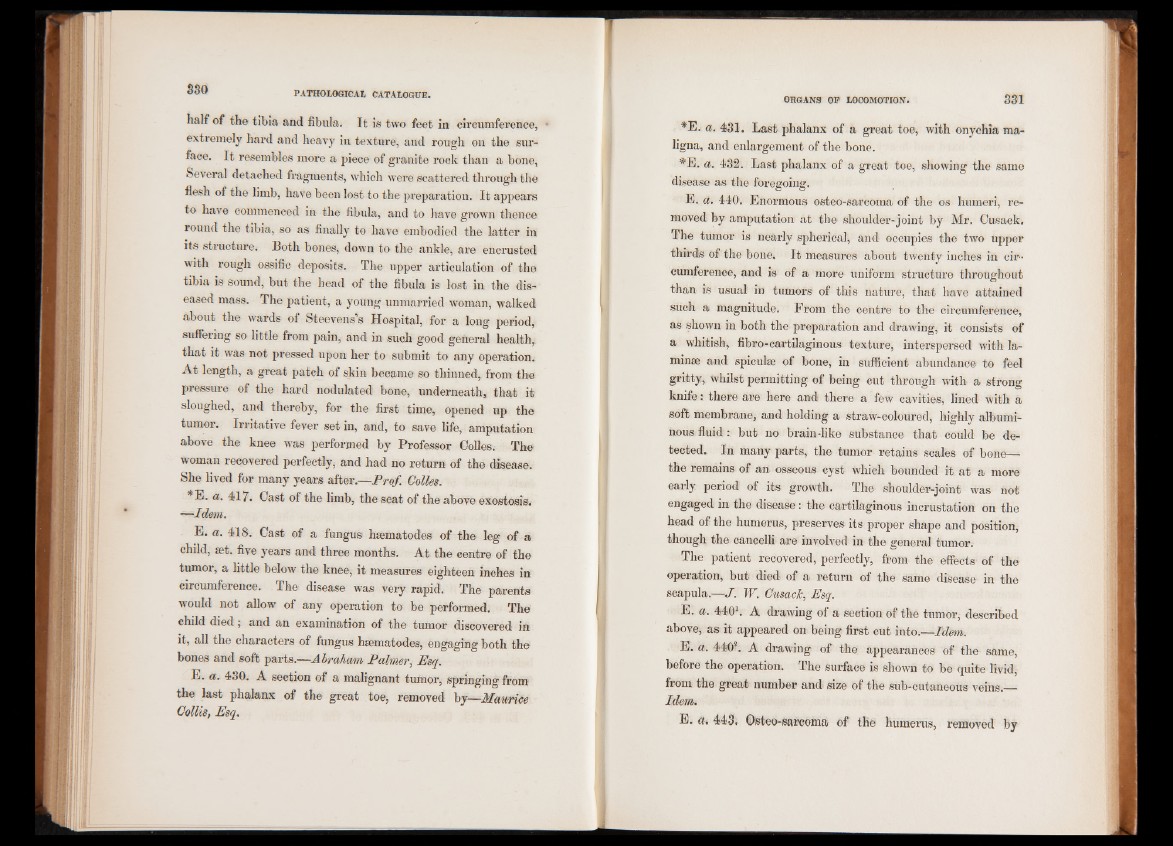
half of the tibia and fibula. It is two feet in circumference,
extremely hard and heavy in texture, and rough on the surface.
It resembles more a piece of granite rock than a bone,
Several detached fragments, which were scattered through the
flesh of the limb, have been lost to the preparation. It appears
to have commenced in the fibula, and to have grown thence
round the tibia, so as finally to have embodied the latter in
its structure. Both bones, down to the ankle, are encrusted
with rough ossific deposits. The upper articulation of the
tibia is sound, but the head of the fibula is lost in the diseased
mass. The patient, a young unmarried woman, walked
about the wards of Steevens’s Hospital, for a long period,
suffering so little from pain, and in such good general health,
that it was not pressed upon her to submit to any operation.
At length, a great patch of skin became so thinned, from the
pressure of the hard nodulated bone, underneath, that it
sloughed, and thereby, for the first time, opened up the
tumor. Irritative fever set in, and, to save life, amputation
above the knee was performed by Professor Colies. The
woman recovered perfectly, and had no return of the disease.
She lived for many years after.—Prof. Golles.
*E. a. 417. Cast of the limb, the seat of the above exostosis.
—Idem.
E. a. 418. Cast of a fungus hsematodes of the leg of a
child, set. five years and three months. At the centre of the
tumor, a little below the knee, it measures eighteen inches in
circumference. The disease was very rapid. The parents
would not allow of any operation to be performed. The
child died ^ and an examination of the tumor discovered in
it, all the characters of fungus hsematodes, engaging both the
bones and soft parts.—Abraham Palmer, Esq.
E. a. 430. A section of a malignant tumor, springing from
the last phalanx of the great toe, removed by—Maurice
Gottis, Esq.
*E. a. 431. Last phalanx of a great toe, with onychia maligna,
and enlargement of the bone.
#E. a. 432. Last phalanx of a great toe, showing the same
disease as the foregoing.
E. a. 440. Enormous osteo-sarcoma of the os humeri, removed
by amputation at the shoulder-joint by Mr. Cusack.
The tumor is nearly spherical, and occupies the two upper
thirds of the bone. It measures about twenty inches in circumference,
and is of a more uniform structure throughout
than is usual in tumors of this nature, that have attained
such a magnitude. From the centre to the circumference,
as shown in both the preparation and drawing, it consists of
a whitish, fibro-cartilaginous texture, interspersed with laminae
and spiculae of bone, in sufficient abundance to feel
gritty, whilst permitting of being cut through with a strong
knife f there are here and there a few cavities, lined with a
soft membrane, and holding a straw-coloured, highly albuminous
fluid : but no brain-like substance that could be detected.
In many parts, the tumor retains scales of bone—
the remains of an osseous cyst which bounded it at a more
early period of its growth. The shoulder-joint was not
engaged in the disease: the cartilaginous incrustation on the
head of the humerus, preserves its proper shape and position,
though the cancelli are involved in the general tumor.
The patient recovered, perfectly, from the effects of the
operation, but died of a return of the same disease in the
scapula.—J. W. GusacJc, Esq.
E. a. 4401. A drawing of a section of the tumor, described
above, as it appeared on being first cut into.—Idem.
E. a. 4402. A drawing of the appearances of the same,
before the operation. The surface is shown to be quite livid,
from the great number and size of the sub-cutaneous veins.—
Idem.
E. a. 443. Osteo-sarcoma of the humerus, removed by